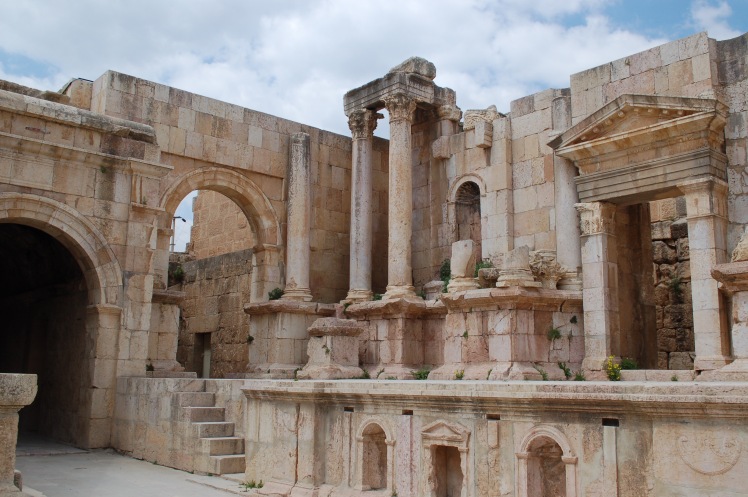The promise of rain seemed ridiculous as I arrived at the Jerash ruins to glorious sunshine and 20° temperatures. These are widely believed to be the best-preserved Roman ruins outside of Italy; it’s possible that much of it even better preserved than I have seen in Italy, perhaps due to the difference in weather.

The modern city of Jerash is located alongside Gerasa of Antiquity, an ancient city housing incredible Greco-Roman architecture, and is positioned in the north of Jordan among rolling hills, and valleys filled with olive trees, pine forest and wheat crops. These fertile lands, and year-round fresh water supply, enabled this ancient city to enjoy great wealth and importance, but in 749AD an earthquake struck the region destroying huge parts of the city that were buried in soil and not rediscovered until 1806 by German explorer Ulrich Jasper Seetzen who was searching for Oriental artefacts.

The main features of the ruins are as follows:
* Hadrian’s Arch: built in 129AD, this marks the ancient city’s boundaries.

* Hippodrome: a restored Roman-era stadium. This was the smallest of the two arenas in the Roman Empire.

* Forum (Oval Plaza): this is the main attraction. Bordered by 160 Ionic columns, it literally cannot be missed!

* The Cardo: a 600m (1,968ft) colonnaded street running the length of the city.

* Temple of Artemis: impressive temple ruins dedicated to the Ancient Greek deity.

* Agora: once the city’s main food market positioned around a central fountain.

* Nymphaeum: an ornate public fountain decorated with lion heads and dedicated to nymphs.

* South Theatre: the larger of the two theatres, this can seat up to 3,000 people. The site is still used for concerts, performances and even the occasional chariot race! Today, there were Jordanian Pipers playing – apparently a Scotsman was in charge of teaching the military music as the British transfer of power occurred after the First World War.

The monuments would largely have been funded by the donations made by the city’s wealthy citizens. From AD 350 there was a large Christian community living in Jerash, and between AD 400-600 more than 13 churches were built, many with fantastic mosaic floors like the one here below:

An ancient synagogue with detailed mosaics, including the story of Noah, was found beneath a church, though I did not come across this today. The use of water power to saw wood or stone is well known in the Greek and Roman world, the invention in Greece occurring in the 3rd century BC. They converted rotary movement from the mill to linear motion using a crankshaft and good examples are known from Hierapolis and Ephesus to the north. The mill is well described in the visitors centre, and is situated near the Temple of Artemis.
Some more photos of the whole site of Jerash:





Following this we went for a fabulous lunch at ‘The Windmills’ where we had traditional Arabic food:

The final destination of the day was Ma’in for a dip in the hot springs. It was a nice way to end the day, but a Saturday visit meant it was very very busy so I would recommend going during the working week if at all possible.

As we drove back to Amman the sunset over the Dead Sea turned into views across to Jericho and Jerusalem lit up for the night – certainly places I will one day visit for a close up look.

Tomorrow we will drive to Petra with some exciting stops along the way…watch this space!